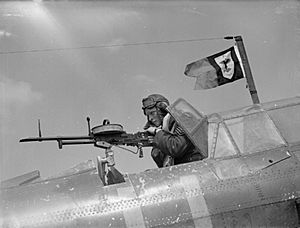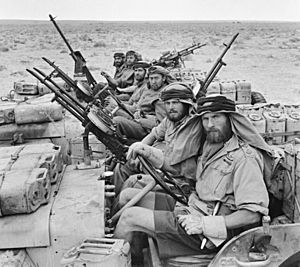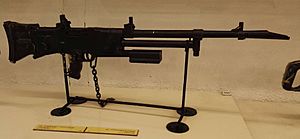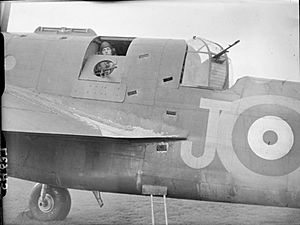Vickers K machine gun facts for kids
Quick facts for kids Vickers Gas Operated |
|
|---|---|

Used on a Fairey Battle light bomber
|
|
| Type | Machine gun |
| Place of origin | United Kingdom |
| Service history | |
| Used by | United Kingdom Vietnam |
| Wars | World War II |
| Production history | |
| Designed | 1935 |
| Manufacturer | Vickers-Armstrongs |
| Variants | See Variants |
| Specifications | |
| Mass | 29.5 lb (13.4 kg) |
| Length | 37 in (0.93 m) |
| Barrel length | 20.8 inches (529 mm) |
|
|
|
| Cartridge | .303 British |
| Calibre | .303 in (7.7 mm) |
| Action | Gas operated |
| Rate of fire | 950-1,200 round/min |
| Muzzle velocity | 2,500 ft/s (760 m/s) |
| Feed system | pan 60/100 rounds |
| Sights | Iron |
The Vickers K machine gun was a very fast-firing machine gun. It was also known as the Vickers Gas Operated (Vickers G.O.). This weapon was made by Vickers-Armstrongs in the United Kingdom. It was first designed for use in airplanes.
Aircraft needed a gun that could shoot many bullets quickly. This was because gunners only had a short time to fire at enemy planes. Later, during World War II, the Vickers K was also used by soldiers on the ground.
Contents
How the Vickers K Machine Gun Was Made
The Vickers K was based on an older gun called the Vickers-Berthier (VB) light machine gun. The VB was used by the British Indian Army starting in 1932.
The Vickers K had parts that moved very quickly. This allowed it to fire between 950 and 1,200 bullets every minute. This was even faster than the German MG34 machine gun!
The British Air Force (RAF) tested the Vickers K. It used a large, round magazine that held 300 bullets. The gun worked very well and was reliable. However, the wide magazine made it hard to fit the gun into the wings of fighter planes.
Because of this, the RAF chose a different machine gun, the Browning Mark II. But the Vickers K still found many other uses. It was used by the Fleet Air Arm (the Navy's air force) until 1945.
Different Types of Vickers K Guns
Some Vickers K guns were made for Belgium before the war. These fired 7.7mm bullets. At least one of these ground versions is still in a museum in Brussels.
VGO No.1 Mk.1.
The Vickers K, or Vickers G.O., machine gun works using gas from the fired bullet. It fires only in full automatic mode. This means it keeps shooting as long as you hold the trigger.
It gets its bullets from a flat, round magazine placed on top. These magazines usually held 100 bullets. But soldiers often loaded only 96 or 97 to make sure they fed smoothly. This gun had a single handle at the back with a trigger. When used on the ground, it was often put on special mounts on jeeps and trucks.
Vickers GO No.2 Mk.1 Land Service
This version was made for RAF airfield defense units. These guns were changed from the original aircraft Vickers G.O. No.1 Mk.1 guns. Many of these 'Vickers G.O. Land Service' machine guns were used by British commando and scout units. They operated in Europe during 1944 and 1945.
The land version had a short stock at the back instead of the single handle. It also had a pistol grip with a trigger below the gun. A small front grip or a folding handle was added under the barrel. A folding stand (bipod) was also attached. New sights were added that could fold down.
Vickers G.O. Camera Gun
A special version of the Vickers G.O. was made for training. This was a camera gun. It looked and felt like a real gun, but it had a camera inside.
When gunners in training "shot" at attacking planes, the camera would take pictures. These pictures were later looked at to see how well the gunners aimed. This training method was first used in World War I.
How the Vickers K Was Used in Battles

The Vickers K was put on light and medium bomber planes like the Fairey Battle and Handley Page Hampden. It was also used in gun turrets on planes like the Bristol Blenheim and the Armstrong Whitworth Whitley.
It was the main machine gun for the Royal Navy Fleet Air Arm. It was used on planes like the Fairey Swordfish, Fairey Albacore, and Fairey Barracuda. As more Browning machine guns became available, the RAF stopped using the Vickers G.O.
These guns were then given to British and Commonwealth army units. The Navy's Fleet Air Arm continued to use them. Their last known use by the Navy was in October 1945, during anti-piracy patrols near Hong Kong.
The Long Range Desert Group (LRDG) used many Vickers G.O. guns on their vehicles. They used them as single guns or in special double mounts. The Special Air Service (SAS) also used them on their jeeps for quick attacks.
Some people thought these special forces used the Vickers G.O. because they couldn't get other guns. But the LRDG and SAS found the Vickers G.O. much better. It fired very fast and worked well even in sand. This made it better than other guns they had, like the water-cooled Vickers or the Bren gun.
Similarly, the Airborne Reconnaissance Squadron used the Vickers G.O. on jeeps. This was during Operation Market-Garden in September 1944. Royal Marine and Army Commandos also used the Vickers G.O. for infantry support around D-Day.
From 1942, the Vickers K also started to replace other guns on Royal Navy boats. It was used on Motor Torpedo Boats, Motor Launches, and other small ships.
See also
- MG 81 machine gun
- ShKAS machine gun




